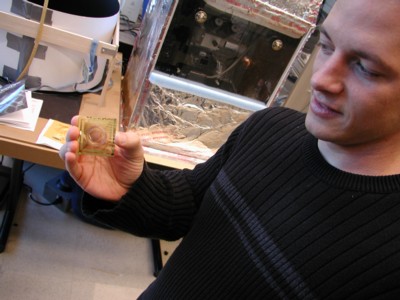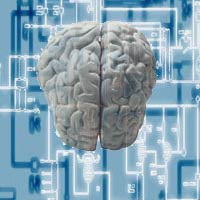This is an article Susan and I completed for Simon Smith at http://www.betterhumans.com with the generous help of ImmInst Advisor, Peter Passaro (OcsRazor) - BJK
Building a Bridge to the Brain
Researchers are close to breakthroughs in neural interfaces, meaning we could soon mesh our minds with machines
Bruce J. Klein
Special to Betterhumans
[Sunday, March 02, 2003] If you're like most people, you've fantasized about downloading Spanish 101 directly into your skull. That dream may become reality sooner than you think.
The prosthetic cochlear implant, for example, is now a commonly used treatment for deafness. Doctors routinely implant electrode arrays into the cochlea, which stimulate nerve fibers to restore hearing.
"I feel great!" said Republican talk show personality Rush Limbaugh after getting a cochlear implant in December 2001 to counteract an ear disease. "The surgery went smoothly and I'm looking forward to enjoying the holidays and returning to the air in early January." Limbaugh remains on the job today, successfully broadcasting thanks to his new bionic hearing.
Blind people could benefit next. Technology has been developed to stimulate the brain's visual cortex using electrodes. Developed by William Dobelle, the vision technology relays signals from a miniature video camera through a signal processor into the brain, which interprets the signals as sight. While in the early stages, it could soon change the lives of more than 40 million blind people worldwide.
While neither technology will help you cram for a test, both show how much progress is being made on neural interfaces, devices that link minds and machines.
Researchers are tantalizingly close to major breakthroughs. Soon, we could be meshing our brains to computers, living, for all practical purposes, on an "immortal" substrate, perhaps eventually discarding our messy, aging, flesh-and-bones body altogether.
But wait, I'm getting ahead of myself here. Let's step back and look at the history of neural electronics to get a better perspective on where we may be headed.
A brief history of neural electronics
Research related to mind-machine interfaces isn't new.
Research on neural networks, for example, dates back to 1943, when Warren McCulloch, a neurophysiologist, and Walter Pitts, a mathematician, wrote about how neurons might work and modeled a simple neural network with electrical circuits.
Work on "thinking machines" continued from there. With the advent of more advanced computer technology it became possible to build new models to test theories about human thought.
Unfortunately, early successes caused people to exaggerate the potential for neural networks. This excessive hype, fueled by academics and science fiction writers such as Isaac Asimov, led to disappointment when success with thinking machines failed to materialize.
In the early 1980s, however, there was renewed interest thanks to the work of John Hopfield of Caltech, who not only wanted to model the brain but also to create useful neural devices. Coupled with a major push by the US to compete with Japan, the interest led to more funding for such devices.
Today, research into neural networks and practical neural interfaces is happening everywhere.
And researchers are making major progress.

PHOTO BY: Susan Fonseca-Klein
Brain on a chip: Neural engineer Peter Passaro holds a microarray containing rat neurons. Microarrays can read brain cell activity, and have already been used to create a rat-brained robot
Microarrays and rat-brained robots
With more powerful computers and promising microarray technology, researchers can now grow brain cells on the surface of silicon chips and measure them in real time.
Dotted with electrodes, microarrays can interpret signals from active neuron cells, and they are helping to spur impressive advancements in neural interfaces.
Steve Potter, a professor working on neuroengineering in the Biomedical Engineering Department at Georgia Tech, is at the cutting edge of such work.
His lab is currently working with a rat-brained robot that Potter calls a "hybrot."
Data is filtered from about 10,000 electrode-activated rat brain neurons and relayed wirelessly to a robotic mouse. About the size of a coffee mug and rigged with real-time sensors, the hybrot interacts with its environment, moving around and sending data back to the live neurons.
"We are especially interested in distributed activity patterns and information processing in these cultured networks," Potter says. "Our plan is to give them a body, and an environment in which to behave."
It is the first time that neurons grown in vitro have controlled a robot's movement.
Major obstacles remain in deciphering and filtering the background noise created by so many neurons firing in tandem.
But the hybrot is a promising proof of concept. The hope is that the research will lead to a better understanding of how the brain works, and that this will allow the construction of smarter computers that can grow and even heal themselves.
"I'm banking my whole career on the fact that there is a world of emergent properties in these neural networks that we don't know anything about," says Potter.
The neural engineers
After meeting a researcher at the Laboratory for Neuroengineering named Peter Passaro through the online forums of the Immortality Institute, my wife, Susan Fonseca-Klein, and I were lucky enough to meet him in person and tour the lab.
"My fantasy is to learn how to send signals to (and program) networks of neurons and to be able to decode their output in real time" says Passaro, a graduate student who is working with Potter. "This is what will be needed for a robust neural implant that you can both send and receive from."
Upon entering the lab, Susan and I were amazed by the bustle of activity. Dozens of fresh-faced students and lab assistants discussed projects or hunched over sprawling bits of wires and electronic gadgetry.
The lab is divided into two main sections, one called the "dry" side and the other called the "wet" side.
On the dry side, Steven DeWeerth, professor of electrical engineering at Georgia Tech, is building circuits. The term "dry" refers to the fact that researchers there are designing artificial chips with wires and silicon to mimic live neurons.
Potter's group, just down the hall, works on the wet side, making advances with the hybrot and doing research that could help DeWeerth's team build better artificial neurons.
The goal is to ultimately bring wet and dry together.
Working on wetware
Susan and I spent the remainder of the tour on the wet side, where Passaro showed us actual neurons growing in vitro.
The neurons are amazingly resilient, some living as long as two years. They are cultured from rat brain embryos, grown on microarrays and kept at a constant temperature to mimic the conditions inside a rat's brain. They are therefore kept in a temperature-controlled box most of the time and observed with a climate-controlled microscope (note the foil box in the background in the picture at right).
Asked about the most interesting discovery made thus far, Passarao says, "So far it has been a lot of just developing the technology to do this. But recently, we have started to understand some of the encoding going on. So we are starting to be able to feed in stimulus and know what the response is going to be."
Essential for human progress
Passaro is a fascinating story himself. A former vice-president of Maximum Life Foundation, an organization with the goal of ending aging, he is an avid proponent of improving the human condition.
Asked about his current work, Passaro points to a quote by Steven Hawking. "We must develop as quickly as possible technologies that make possible a direct connection between brain and computer," Hawking has said, "so that artificial brains contribute to human intelligence rather than opposing it."
Passaro says that Transhumanism has fascinated him since he was a boy. "I have always felt it was human destiny and our deep purpose to make our world a better place and to make ourselves better creatures," he says.
Work on neural interfaces is key to this. While humans as biological creatures represent a good start, we're doomed to death from many age-related problems -- not to mention from falling off a cliff or getting hit by a car -- and our biology cannot keep up with our technology.
Augmenting, transforming and uploading
Personally, I'm optimistic about the future. I find myself continually thinking about where we'll be in 10, 100 or even 1,000 years.
Most people say, "you can't live that long." But I remain confident, and the work of Passaro and others like him show that we can not only create a better future for our grandchildren but also be there with them to enjoy it.
Today it may be rat-brained robots, but tomorrow we'll have technologies much more powerful. If we expect to live for thousands of years -- and I do -- then we'll need to transform, augment and upload our minds.
Alexander Bolonikn has boldly expressed this idea, calling for a future "electronic man" or "e-man."
According to Bolonikn, we can only solve the problem of mortality by moving from our biological substrate. "An immortal person made of chips and supersolid materials (the e-man, as it was called in my articles) will have incredible advantages in comparison with common people. An e-man will need no food, no dwelling, no air, no sleep, no rest, no ecologically pure environment. Such a being will be able to travel into space, or walk on the sea floor with no aqualungs. His mental abilities and capacities will increase millions times."
Are we ready to make the leap to electronic immortality? Not just yet. But work on neural interfaces shows that it's coming, and coming at an ever-increasing rate.
Bruce J. Klein and Susan Fonseca-Klein are co-directors of the Immortality Institute for Infinite Lifespans.
















































